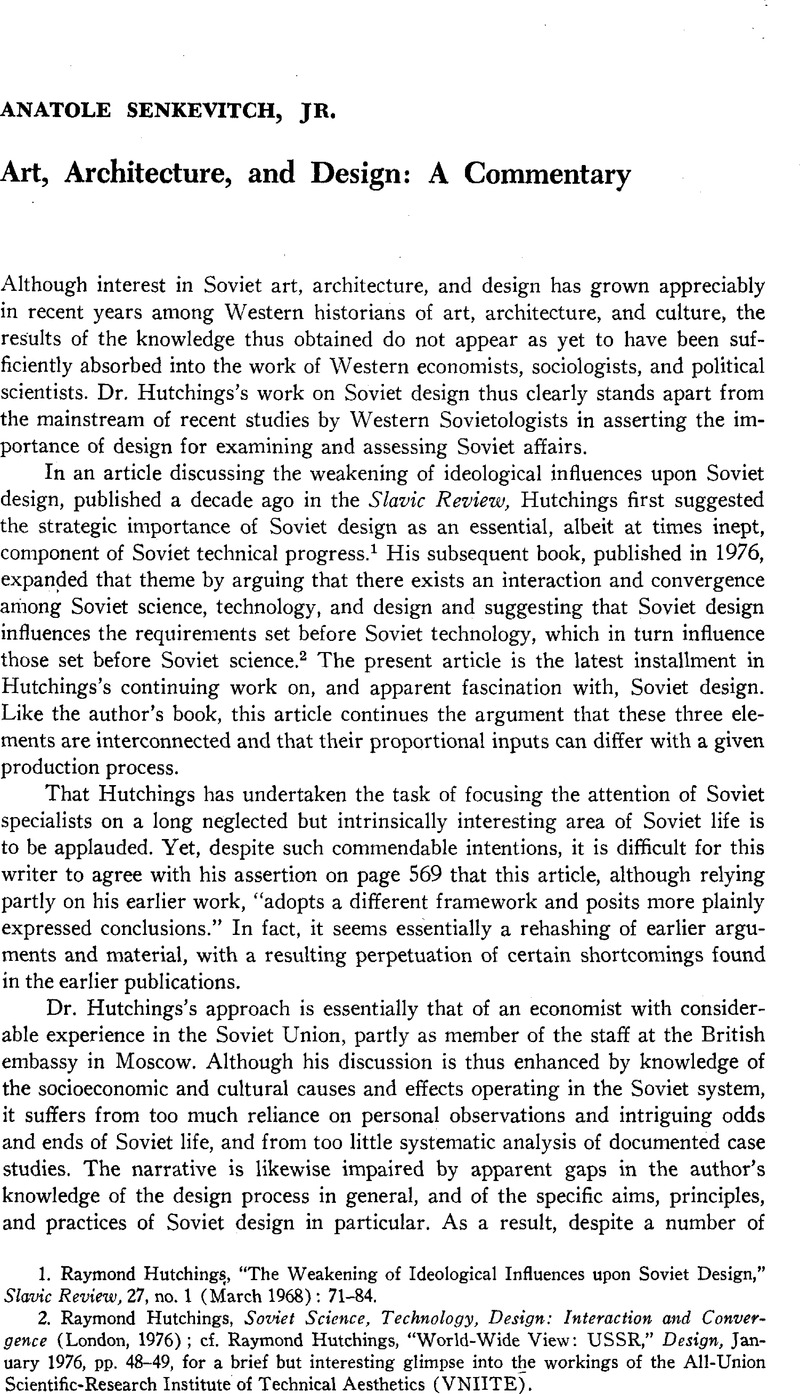No CrossRef data available.
Article contents
Art, Architecture, and Design: A Commentary
Published online by Cambridge University Press: 27 January 2017
Abstract

- Type
- Discussion
- Information
- Copyright
- Copyright © Association for Slavic, East European, and Eurasian Studies. 1978
References
1. Raymond, Hutchings, “The Weakening of Ideological Influences upon Soviet Design,” Slavic Review, 27, no. 1 (March 1968): 71–84.Google Scholar
2. Raymond, Hutchings, Soviet Science, Technology, Design: Interaction and Convergence (London, 1976)Google Scholar; cf. Raymond Hutchings, “World-Wide View: USSR,” Design, January 1976, pp. 48-49, for a brief but interesting glimpse into the workings of the All-Union Scientific-Research Institute of Technical Aesthetics (VNIITE).
3. Among the most illuminating treatments of industrial design are Henry, Dreyfuss, Designing for People (New York, 1955)Google Scholar; Drexler, Arthur and Daniel, Greta, Introduction to Twentieth-Century Design (New York, 1959)Google Scholar; Michael, Farr, Design Management (London, 1966)Google Scholar; and George, Nelson, Problems of Design (New York, 1957).Google Scholar
4. Solov'ev, Iurii B., “Tekhnicheskaia estetika,” Bol'shaia sovetskaia entsiklopediia, 3rd ed., vol. 25, ed. Prokhorov, A. M. (Moscow, 1976), p. 527–28.Google Scholar A number of publications issued by VNIITE sought earlier to illuminate the emerging Soviet conception of technical aesthetics. Among the most informative are the journal Voprosy tekhnicheskoi estetiki (Moscow, 1968-70) and the subsequent compendium Osnovy tekhnicheskoi estetiki: Rasshirennye tesisy (Moscow, 1970). More general but informative discussions of recent Soviet design can be found in Kantor, K. M., Krasota i pol'za (Moscow, 1967)Google Scholar, and Glozychev, V. L., O dizaine (Moscow, 1970).Google Scholar
5. Solov'ev, “Tekhnicheskaia estetika,” pp. 527-28.
6. Ibid.
7. Ibid.
8. Perhaps the most descriptive formulation of the Productivist program, which became the cornerstone of Constructivist aesthetics in Soviet art, is found in Aleksei, Gan, Konstruktivism (Tver, 1922).Google Scholar One of the earliest discussions of the synthesis of art and industrial production is the compendium issued by the Artistic-Industrial Council of the People's Commissariat of Enlightenment entitled Iskusstvo v proizvodstve (Moscow, 1921). For information on the VKhUTEMAS, see, among others, Zhadova, L, “Vkhutemas-Vkhutein (stranitsy istorii),” Dekorativnoe iskusstvo SSSR, 1970, no. 11, pp. 36–43Google Scholar; and Marts, L., “Propedevticheskii kurs Vkhutemasa-Vkhuteina (osnovnoe otdelenie),” Tekhnicheskaia estetika, 1968, no. 2, pp. 31–34; 1968, no. 4, pp. 27–29Google Scholar; and 1968, no. 12, pp. 25-27. This episode is also discussed in Anatole Senkevitch, Jr., “Trends in Soviet Architectural Thought, 1917- 1932: The Growth and Decline of the Constructivist and Rationalist Movements” (Ph.D. diss., Cornell University, 1974).
9. Perhaps the most illuminating studies of Soviet consumerism are those by Philip Hanson: his initial The Consumer in the Soviet Economy (Evanston, 111., 1968), is a systematic effort to measure and compare Soviet consumption with that in other countries, especially the United Kingdom. This study has been updated and given a rather insightful cast in respect to current Soviet consumer trends in Philip, Hanson, Advertising and Socialism: The Nature and Extent of Consumer Advertising in the Soviet Union, Poland, Hungary, and Yugoslavia (White Plains, N.Y., 1974).Google Scholar
10. Among the more illuminating treatments of this development are those provided in Conyngham, William J., Industrial Management in the Soviet Union (Stanford, 1973)Google Scholar; Gregory, Paul R. and Stuart, Robert C., Soviet Economic Structure and Performance (New York, 1974)Google Scholar, part 4; and Christopher Stowell, E. et al., Soviet Industrial Import Priorities (New York, 1975).Google Scholar
11. The shift from extolling to repudiating the design validity of the Stalinist skyscrapers came in short order with Khrushchev's denunciation of the decorative excesses in recent Soviet architecture in a speech to the All-Union Conference of Builders and Architects on December 7, 1954. Proclaiming that Soviet building had urgently to adopt industrialized mass construction techniques in order to erect greater numbers of more economical and functional housing, Khrushchev denounced the Moscow skyscrapers for epitomizing the trend of individualized rather than standardized design, with its emphasis on excessive ornamentation and on complex silhouettes with spires incongruously recalling medieval Moscow churches (a resemblance encouraged by Stalin). It was the excessive cost of constructing these elaborate buildings, rather than their artistic content per se, that proved the central focus of Khrushchev's campaign. Still, his remarks bore unmistakable traces of aesthetic preferences and implications with the suggestion that such an approach revealed “the absence of taste on the part of certain architects” ( Khrushchev, Nikita S., O shirokom vnedrenii industrial''nykh metodov, uluchshenii kachestva i snizhenii stoimosti stroitel'stva [Moscow, 1955], p. 20).Google Scholar Dismissing out of hand the notion that these buildings could seriously be regarded as beautiful, he declared: “In our opinion, it is better to criticize their shortcomings, because, if we don't do so now, then the imitation of these tall buildings will continue to spread …” (ibid., p. 21).




